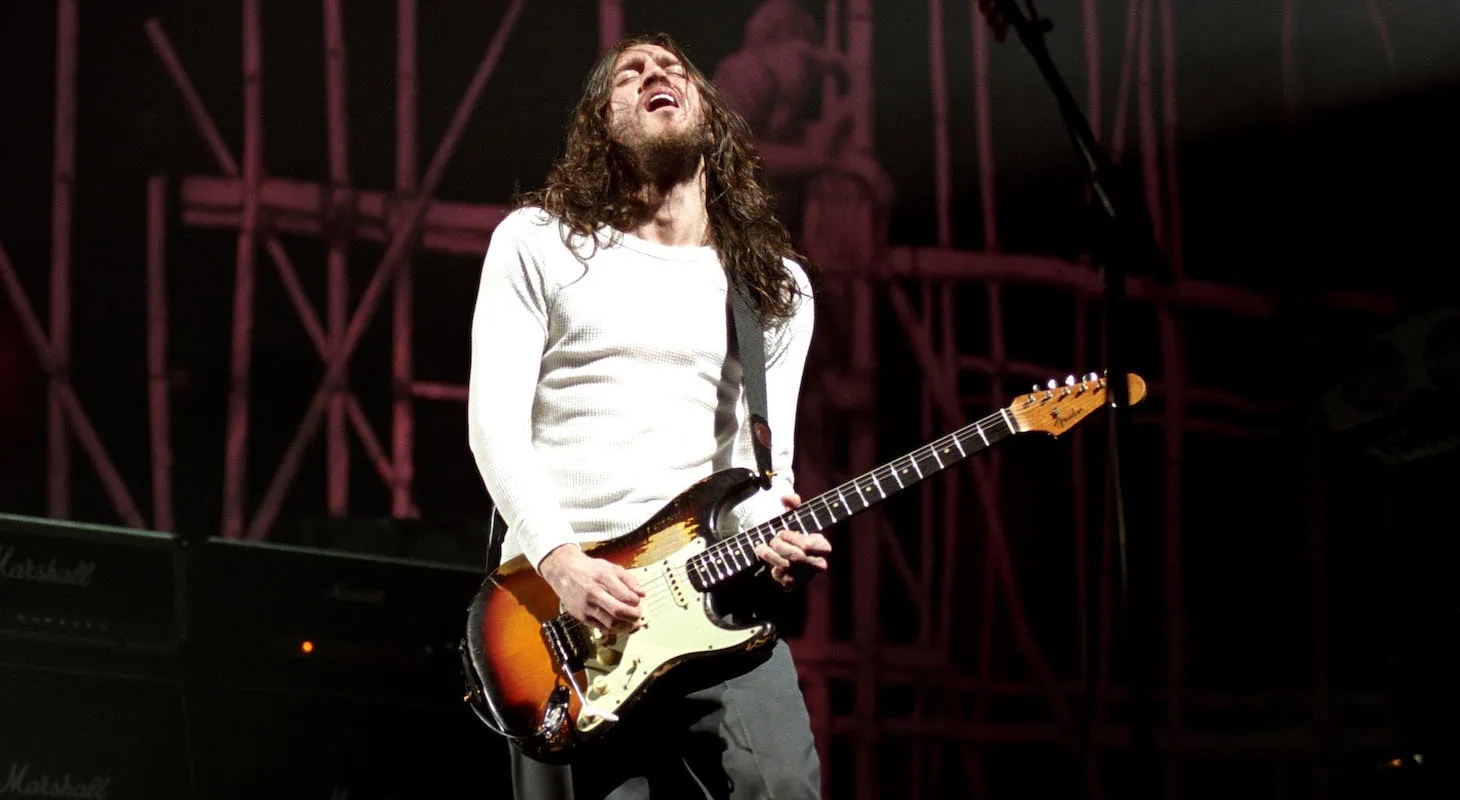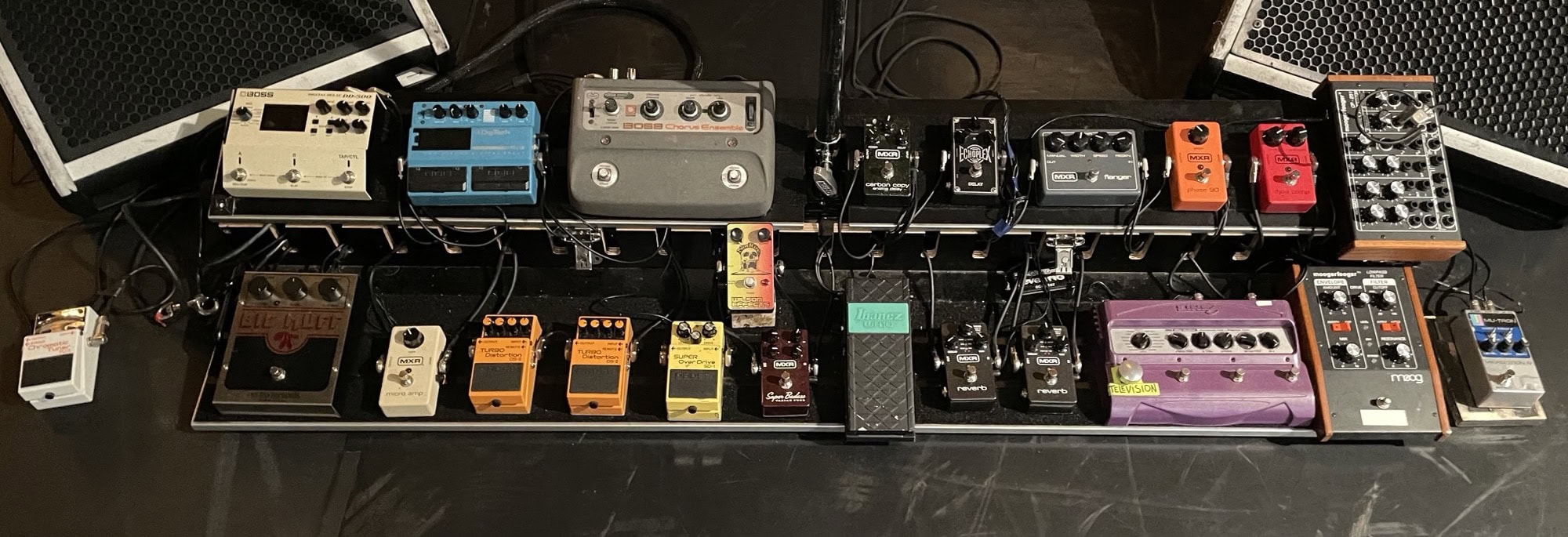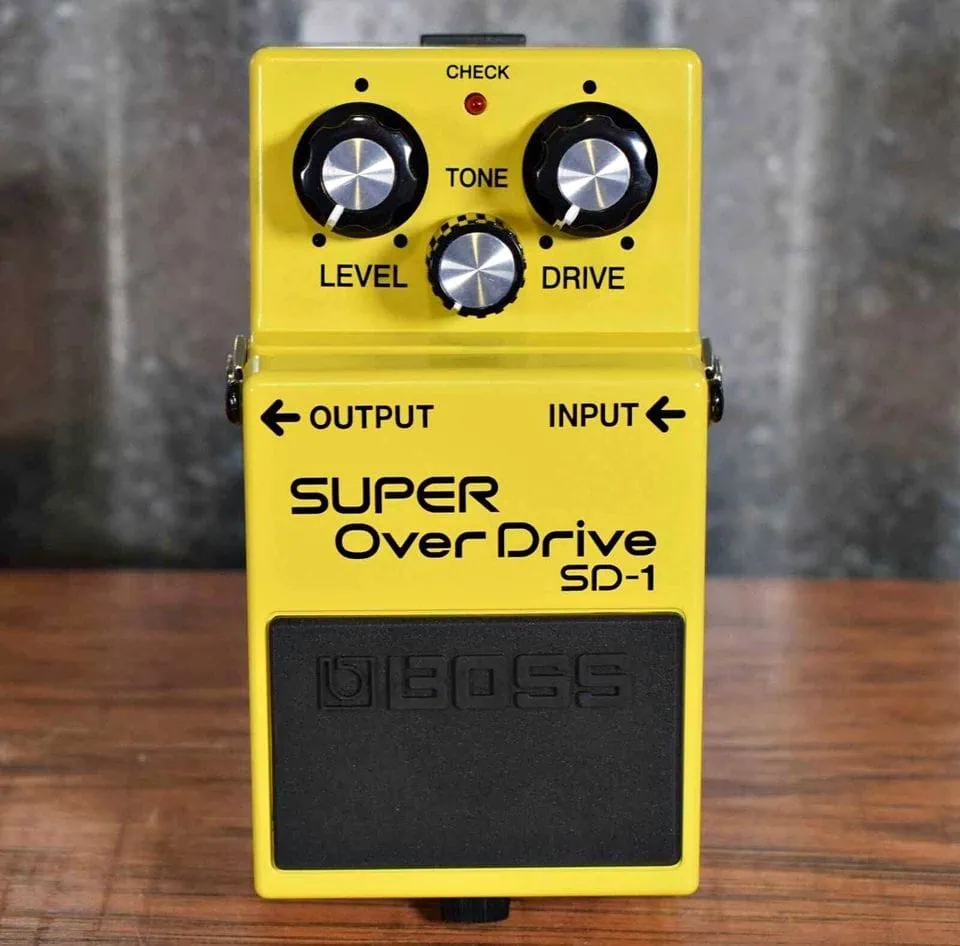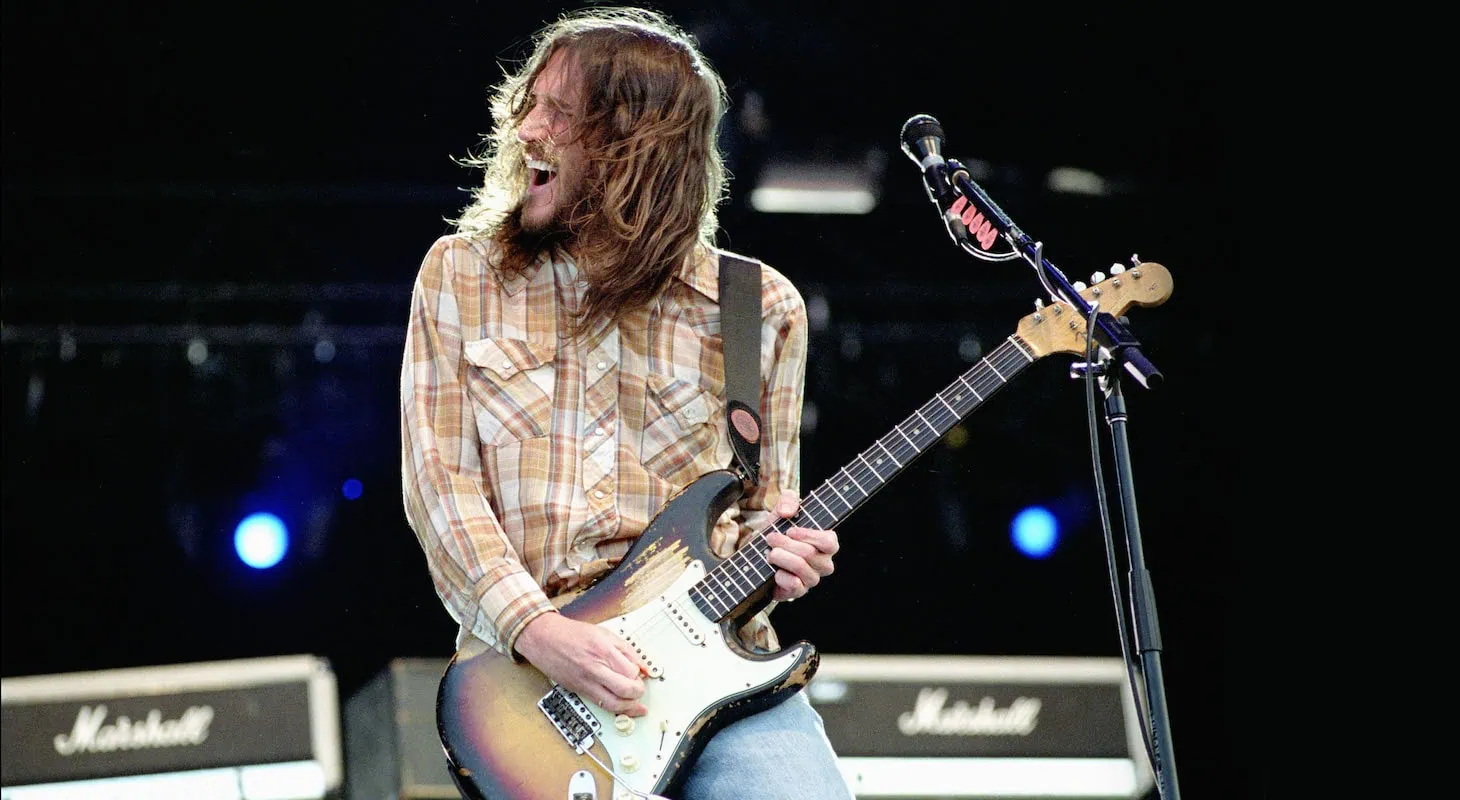California funk-rock icons the Red Hot Chili Peppers have been dominating the charts and stadium stages around the world for decades now. Anyone who saw the band’s chaotic, unbridled early work would be shocked to learn that, in 2025, they’re one of the biggest rock bands on the planet.
I was in high school when Stadium Arcadium hit the charts, and “Dani California” leapt out of every car speaker within earshot. As a budding guitar player, I quickly fell in love with John Frusciante’s virtuosic, melodic playing. I spent hours learning the riff from “Snow” and craving the fuzzed-out, distorted tone form the “Can’t Stop” solo.
Today, those hours are finally paying off, as I run through the key ingredients of John Frusciante’s Red Hot Chili Peppers tone. In particular, I’m going to go over the three main sounds I associate with his playing: a clean, compressed tone, as heard on “Under the Bridge,” the slightly dirtier sound of “By The Way,” and the full-on Hendrixian fuzz of “Dani California.”
Let us take a look at the gear and amp settings he uses to create such a fantastic guitar tone.
John Frusciante’s Guitars
Of course, the best way to recreate John Frusciante’s sound is by using similar gear. That means using the right guitar.
While Frusciante has used a number of different guitars throughout his career, he is perhaps best known for playing Fenders - specifically, the Fender Stratocasters.

There are a few specifics to Frusciante’s Stratocasters that keen-eyed (and keen-eared) Chili Peppers fans will want to adhere to. For a start, John Frusciante overwhelmingly plays Stratocasters with rosewood fretboards.
Similarly, he clearly prefers brighter, more treble-forward pickups. Over the years, he’s dabbled in a range of pickups, including Seymour Duncan SSL-1 pickups, but for the most part Frusciante has used stock Strat single-coils.
Frusciante overwhelmingly plays vintage Fender instruments: almost all of his guitars (except his custom-built Fender signature models) predate 1970. I, like most working musicians, don’t have the budget for a vintage 1960s Stratocaster, nor for the Custom Shop '60s Strat reissue. Fortunately, Fender produces a much more affordable Vintera '60s Stratocaster, as well as an even more competitively priced Squier Classic Vibe '60s Strat.
Frusciante also used a 1963 Fender Tele during the recording of By The Way. If you want that album’s specific sound or just want a more twangy sound, the Fender American Professional II Telecaster is a great modern option. Go with the sunburst finish, of course.
Another important guitar to mention is his Gretsch White Falcon. It is debated whether Frusciante had a 1955 or a 1965 White Falcon. Frusciante used this guitar live to play some of the Red Hot Chili Peppers’ biggest hits like Californication and Otherside.

Gretsch G6136T-59GE White Falcon
Teles and Falcons aside, I get the closest to John Frusciante’s tone when I’m playing a Stratocaster. The pickups need to be nice and bright to achieve his cutting, incendiary tone.
Frusciante has used a number of other guitars from Gibson, Ibanez, as well as other Fenders. The three I talked about above are among his most well-known and iconic.
John Frusciante’s Amps
Now that you have the right guitar, it is time to get the right amp. Just like his guitars, Frusciante has used a number of different amp heads and cabinets. But there is one pairing that can be considered his go-to.
For the amp head, Frusciante uses a Marshall Silver Jubilee. Frusciante also owns a rare vintage Marshall Major, a 200-watt head that is, for all intents and purposes, a Marshall Plexi with extra headroom.
Typically, Frusciante likes the Jubilee for dirtier tones, and the Major for cleaner ones. However, the difference here, to my ear, is negligible. I don’t need two hundred watts of Marshall tube power for my clean sounds: my Plexi combo does just fine.
Frusciante, to play stadiums, uses full Marshall 4x12 stacks, but an MX212R or MX412BR will work great depending on how much power you are looking for.
Getting your hands on both a Silver Jubilee and a 1060BX can set you back quite a bit. For something slightly cheaper, a Marshall SC20C is a great alternative.
For me, I’m happy to use any all-tube Marshall combo. I get the closest with the 2525C, which is for all intents and purposes a single-speaker Jubilee combo. My Studio Vintage combo, at lower volumes, is gets pretty close to his clean sound, too.
For most of us with a serious budget constraint, however, here are a few more amp suggestions for getting pretty close to the John Frusciante tone.
- Blackstar HT-5R MK3 (5W tube amp under $600)
- BOSS Katana 50 or Positive Grid Spark 2 (we have a comparison article to help you decide)
The Katana and Spark are useful in this context mostly for their capacity to emulate a classic Marshall tone.
As with John Frusciante’s guitar, the amp’s voicing needs to be bright and biting. Frusciante uses full Marshall stacks, but it’s entirely possible to get in the ballpark of his Chili Peppers tone with a combo.
John Frusciante Amp Settings - RHCP Tone!
Once you have got the right guitar and amp, you can start dialing in John Frusciante’s tone.
The Stratocaster is a naturally bright guitar. Likewise, the Marshall is a naturally bright amp.
I find best results, across all volume levels, by cranking the bass knob on my Marshall-and-Strat combo. That means, Hendrix-style, turning the bass up to 10. Marshall EQs, particularly the vintage ones like John plays, can only remove frequencies, not add them, so 10 is just the most bass this amp can offer.
Frusciante’s guitar needs to cut through the midrange reasonably well, so I like the sweet spot of 6/7.
Because the Strat is so bright, especially on the bridge pickup as Frusciante prefers to play, I set the treble to 4.
Here’s the key to this tone on a Marshall amp:
John Frusciante plays vintage four-hole Marshalls. That means there are two separate channels: one bright channel and one normal channel.
The vast majority of the EQing John Frusciante does is accomplished by blending these two channels via a short cable. He plugs a patch lead into both channel one and two, and his guitar lead into the second input for channel one.
To balance the sound, he sets the volume for the brighter channel to 4 and the darker channel to 7. These are near-identical volume levels on a Marshall amp: 7 is not twice as loud as 4. It simply blends the two tones into a more evenly paced sound ideal for a Stratocaster.
The Presence knob I typically set depending on the room I’m playing in. Very harsh, hard rooms demand less Presence, and warmer, larger venues and studios demand more.
I’ve seen photos of Frusciante’s own Marshalls with the EQ below:
- Presence: 6
- Bass: 10
- Mids: 6-7
- Treble: 4
- Volume 1: 4
- Volume 2: 7
To achieve varied tones mid-song, John adjusts his technique, playing closer to the bridge for a brighter sound, especially when overdriven, and closer to the neck for a warmer sound when playing clean.
I recommend starting with these settings, and adjusting to taste, according to your own ears.
Apart from this general guideline, here are a few more specific Red Hot Chilli Peppers amp settings for some of their most iconic songs.
I tend to use the settings above as a baseline for Frusciante tone. I then, as he does, use a few key pedals (as outlined in the next section) to suit each song: the same amp settings can apply to “By The Way” as to “Snow” with the right signal chain.
Californication:
- Bass: 10
- Mids: 6
- Treble: 6
- Gain: 2
Can't Stop:
- Bass: 10
- Mids: 5
- Treble: 7
- Gain: 4 (or lower, using a drive pedal with the Level maxed and the Gain lowered)
Scar Tissue:
- Bass: 10
- Mids: 6
- Treble: 7
- Gain: 3
Dani California:
- Bass: 10
- Mids: 5
- Treble: 7
- Gain: 2 (use a distortion pedal for the solo)
John Frusciante Pedalboard - Notable Effects Pedals
For effects and solos, John Frusciante has used a number of pedals throughout his career, and his pedalboard has actually increased quite a bit in size over the years.
Of late, he’s been using a truly gargantuan pedalboard: it’s more like three boards in total. Even in an era of most stadium rock bands switching to profilers, John Frusciante gets most of his sound from pedals.

John Frusciante's pedalboard, during a live show in Jan '23.
Those of us without the budget or the roadies to carry around multiple racks of vintage effects have to make do with a few key effects to get in the tonal region of John Frusciante’s sound.
These are:
- A preamp/tone conditioner. In his case, the MXR Micro Amp
- A wah, in his case the Ibanez wah
- A compressor, the MXR Dyna Comp
- A vintage Boss CE-1 chorus unit (I generally use a CE-2 instead)
- A softer drive, such as SD-1
- For distortion, the Boss DS-2
- Fuzz, ideally a Big Muff Pi or the Variac Fuzz
Frusciante likes to paint with as many colors as possible, so he tends to add a few different reverbs, delays, and drives. The full extent of his touring rig is catalogued elsewhere, so here I’ll take you through how I like to run the above for Frusciante tone.
As a starting position, I’ll talk about John’s clean tone, as heard on “Californication” or “Under The Bridge.” A nice squashy compressor livens up the otherwise anemic tone of a totally clean Strat. For some extra subtle life, John sometimes kicks on his chorus unit for clean sounds.
I find that the MXR Micro Amp is necessary for the additional push and life in his signature clean tone. It’s not exactly a distortion pedal or a drive: I like to use it to get the clean sound to what feels like a hair below the beginning of overdrive.
This is also great for the spanky funk rhythm playing on songs like “Around the World” and “By The Way.” It evens out the peaks and troughs in that kind of high-range seventh-chord technique.
For dirtier, but not quite clean, tones such as “Scar Tissue,” this is imperative. I’ve had some luck getting in the ballpark of this sound with a lighter overdrive (like John’s favored SD-1) running fairly low-power.

The general rule here, for me, is to run the Level knob on the pedal as high as possible without going into breakup, and the Gain knob as low as possible without losing signal power.
It’s key not to let the drive take over here: it needs to be just below the gain threshold. I’ve spent hours experimenting with this, and it’s a worthy endeavor.
For dirtier rock tones, John Frusciante turns off the compression effect, because he leans towards sounds that are distorted enough to compress on their own. This is where the DS-2 comes in: it’s been a staple of his tones since the '90s.
The DS-2 is, unlike, say, the SD-1, an indispensable piece of this puzzle. It’s absolutely vital for the distorted playing on “Suck My Kiss” as it is for the more modern stuff like “Black Summer.”
John Frusciante loves to use a wah pedal for extra expression. His choice of wah is the Ibanez wah, but a vintage-voiced Cry Baby or Vox wah will do, too.
Some sounds seem like wah, but aren’t: the syncopated lines from the “Dani California” verse are actually an envelope filter. A Q Tron might be the best bet here.
By far my favorite Frusciante effect, and the lead guitar sound most guitar players want to emulate, is his Hendrixian fuzz tone. I’ve been able to get in the ballpark of the solo tone from “Dani California” and “Black Summer” with my Big Muff Pi, which I know John used for years. He is also partial to the slightly less aggressive fuzz sound of the MXR Variac Fuzz.

EHX Silver Big Muff Pi Pedal
John Frusciante uses a range of delays and reverbs. I’m of the opinion that one is usually enough. At a stretch, one delay, one reverb. The EHX Holy Grail is a great choice. Boss’ flagship digital delay is probably best for playing in a band as it cuts through the mix very neatly.
For me, a Chili Peppers-worthy Frusciante setup goes as follows:
Guitar > Dyna Comp > Micro Amp > Fuzz > DS-2 > SD-1 > Wah > Chorus > Delay/Reverb > Amp
These are never all on at the same time, and the signal path will sound a little different with the pedals placed in different orders. It’s worth playing around with different signal paths to see what sounds you create: the essence of John Frusciante’s playing is boundless creativity.
Final Thoughts
Sometimes the most iconic guitar sounds are made using the simplest setups. John Frusciante is proof that you don’t need anything more than a guitar and an amp to create a distinct sound that is recognized by almost everyone.
And now you also have the tools and the know-how to recreate the sound of one of the most recognizable bands in the world.


Thank you for the input, just starting out and I love his style and sound